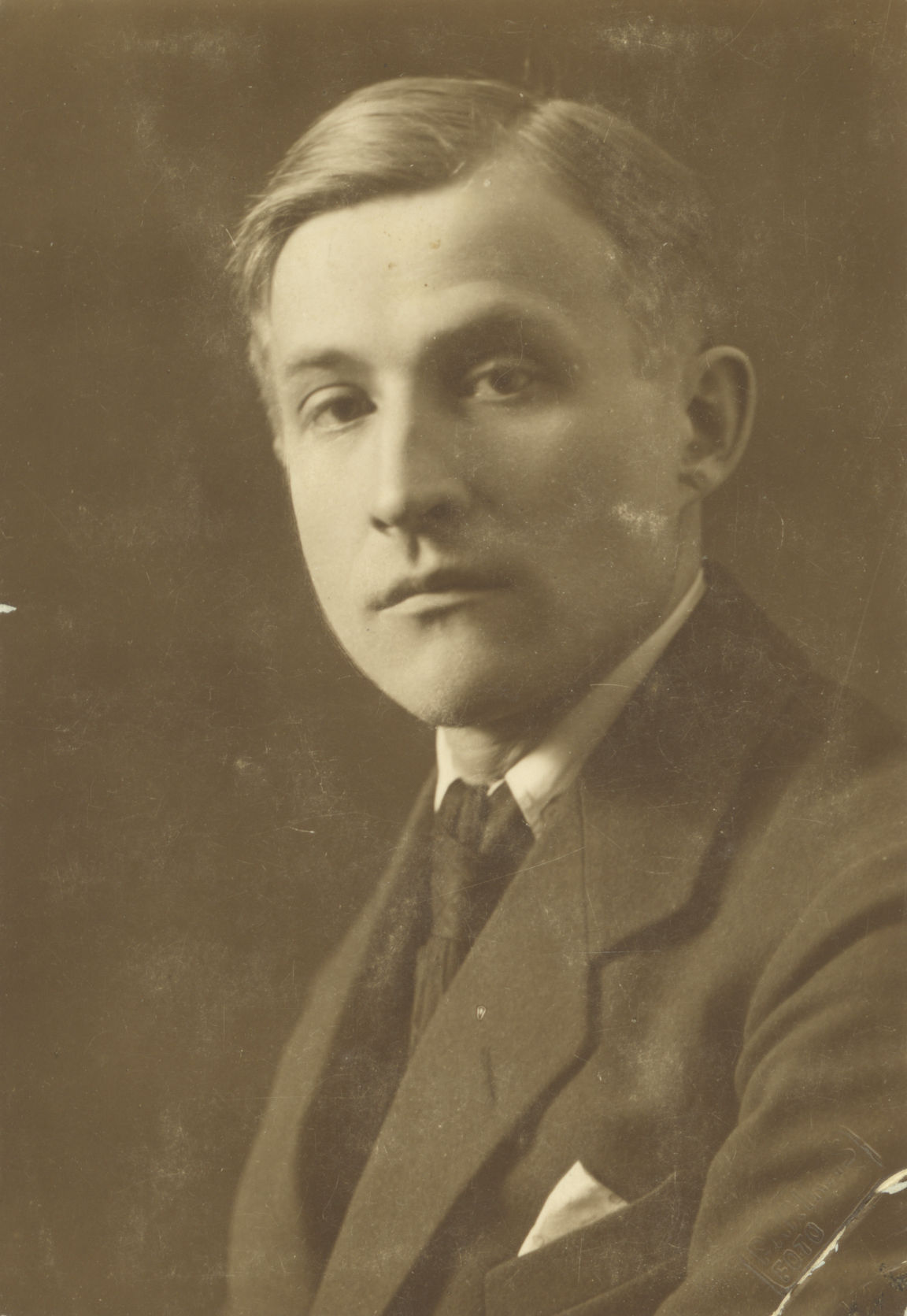
Jaan Kärner
Jaan Kärner (27. V 1891 – 3. IV 1958) was one of the most prolific authors in the history of Estonian literature, publishing poetry, prose, criticism and literary studies.
Kärner was born in Rõngu parish in Tartu county, the son of the owner of Kinksepa farm in the village of Käo. From 1901 to 1906 he attended Uderna primary school, and in 1911-1912 and 1914 he studied at the faculty of history at Shanyavsky university in Moscow. From 1910 to 1917 he worked in the editorial offices of several newspapers. After the February Revolution Kärner entered politics on the left wing (as a member of the Estonian Independent Socialist Workers’ Party) and edited left-wing newspapers. In 1921 he settled in Elva as a professional writer; from 1936 to 1941 he lived in Tartu. From 1927 to 1929 he was the editor of the journal Looming. In 1940 Kärner supported Estonia’s incorporation into the Soviet Union. From 1940 to 1941 he worked at the Ilukirjandus ja Kunst publishing house. After the outbreak of the Second World War Kärner moved away from the German occupation, behind the Soviet front line. From 1944 to 1946 he worked again in publishing and as the editor of Looming. In 1946 Kärner succumbed to mental illness, and spent the last 12 years of his life in Tartu, unable to work and cared for by his family.
It is his poetry that has stood the test of time best out of Jaan Kärner’s work. The best of his lyrics have taken their place among the classics of Estonian poetry. They are profound, sensitive to nature and written with a respect for the permanent values of life and the expressiveness of the Estonian language. Kärner had a good command of the poetic forms originating in the Romantic period. His collections of poetry from the Second World War are passionately propagandistic and superficial. Altogether Jaan Kärner published 12 collections of poetry, 10 novels, four plays, three books of criticism and three studies of theatre history as well as numerous articles in periodicals. His most outstanding books of poetry are the collections Lõikuskuu (‘Harvest Month’, 1925) and Rändur vilistab (‘The Wanderer Whistles’, 1928) as well as the verse novel Bianka ja Ruth (‘Bianka and Ruth’, 1923). Of Kärner’s novels, those of most enduring value are Soodoma kroonika (‘Chronicle of Sodom’, 1934) about life in a small town, and the proto-feminist Naine vaesest maailmast (‘Woman From a Poor World’, 1930).
Jaan Kärner was a prolific translator of the classics of German and Russian literature (Schiller, Goethe, Heine, Fontane, Griboyedov, Pushkin, Krylov, Chukovsky, Chekhov, Tolstoy and others).
L. P. (Translated by C. M.)
Books in Estonian
Poetry
Tähtede warjud: Luuletused 1909–12 nende tekkimise järjekorras. Tartu: K. Sööt, 1913, 70 lk.
Maises ringis: luuletused 1913–18. Tartu: Noor-Eesti, 1919, 61 lk.
Aja laulud. 1919–20. Tallinn: Varrak, 1921, 78 lk.
Bianka ja Ruth. Tartu: Noor-Eesti, 1923, 157 lk. [Novel in verse.]
Lõikuskuu: luuletused 1921–25. Tartu: Loodus, 1925, 71 lk.
Õitsev sügis: luuletused 1925–26. Tartu: Sõnavara, 1926, 96 lk.
Rändur vilistab: luuletisi 1926–28. Tartu: Sõnavara, 1928, 96 lk.
Tormilüüra: seitsmes kogu värsse (1928–29). Tartu: Eesti Kirjanikkude Liit, 1929, 80 lk.
Inimene ristteel: kaheksas kogu värsse (1930–1932). Tartu: Eesti Kirjanikkude Liit, 1932, 79 lk.
Sõna-sütega: luuletusi 1932–1934. Tartu: Noor-Eesti, 1936, 93 lk.
Käidud teedelt: kümnes kogu värsse. Tartu: Noor-Eesti, 1939, 62 lk.
Võitluslaule: valimik autori seniilmunud luuletoodangust 1920–1940. Tartu: Ilukirjandus ja Kunst, 1940, 61 lk.
Kodumaa käsk: antifašistlikke luuletusi 1941–1942. Moskva: Võõrkeelse Kirjanduse kirjastus, 1943, 38 lk.
Viha, ainult viha: poeeme ja luuletusi 1943. Leningrad: Ilukirjandus ja Kunst, 1944, 75 lk.
Suur oktoober: valimik luuletusi. Tallinn: Ilukirjandus ja Kunst, 1947, 30 lk.
Luulevalimik. Tallinn: Eesti Riiklik Kirjastus, 1951, 168 lk.
Novels
Inimene ilma eluloota. Tartu: Noor-Eesti, 1923, 160 lk.
Naine vaesest maailmast: Lilli Niitmaa jutustus. Tartu: Noor-Eesti, 1930, 244 lk.
Unustatud Emajõgi. Tartu: Noor-Eesti, 1930, 222 lk.
Moodne orjus: tõsielu-romaan. Tartu: Noor-Eesti, 1931, 230 lk.
Soodoma kroonika. Tartu: Noor-Eesti, 1934, 282 lk.
Tõusev rahvas. I. Tartu: Noor-Eesti, 1936, 405 lk.
Tuuled pöörduvad läände. Tartu: Noor-Eesti, 1937, 257 lk.
Tõusev rahvas. II. Tartu: Noor-Eesti, 1937, 370 lk.
Pidu kestab. Tartu: Eesti Kirjastus Kooperatiiv, 1938, 346 lk.
Öösiti kumavad linnad. Tartu: Noor-Eesti, 1939, 302 lk.
Short prose
Kõigest tugevam: novell. Tallinn: Varrak, 1920, 70 lk.
Plays
Ainus idealist: kurblõbus komöödia kolmes waatuses. Tallinn: T. Mutsu, 1922, 84 lk.
Kangelane: komöödia kolmes vaatuses. Tartu: Odamees/Carl Sarap, 1924, 150 lk.
Merihärg & Ko ajab Venemaaga äri: komöödia kolmes vaatuses. Tartu: Noor-Eesti, 1932, 83 lk.
Usutaganeja: draama neljas vaatuses. Tartu: Noor-Eesti, 1934, 71 lk.
Memoirs
Kadunud aegade hämarusest: mälestuskilde lapse-, karjase- ja koolipõlvest. Tartu: Eesti Kirjastuse Kooperatiiv, 1935, 162 lk.
Literary studies
Eesti teatri ajalugu. Tallinn: T. Mutsu, 1922, 32 lk.
Eesti teatri tekkimine ja esialgne arenemine. Tallinn: T. Mutsu, 1922, 136 lk.
Eesti näitelava 19. aastasajal. Tallinn: T. Mutsu, 1923, 48 lk.
Lehed tuulde: ääremärkusi ja arvustusi 1911–22. Tartu: Sõnavara, 1924, 128 lk.
Eesti uuemad luuletajad: kriitiline ülevaade eesti luulest 1914–1924. Tartu: Sõnavara, 1925, 128 lk.
„Estonia“ kuuskümmend aastat: kroonika 1865–1925. Tallinn: T. E. S. Estonia, 1925, 178 lk.
Lehed tuulde: esseid ja artikleid 1925–1937. Tartu: Noor-Eesti, 1937, 458 lk.
Lehed tuulde: ajaloolisi ja kultuuriloolisi uurimusi, kirjanduskriitikat, publitsistikat. Tallinn: Eesti Riiklik Kirjastus, 1958, 444 lk.
Historical studies
Talurahwa wabastamine Eestimaal: Wabastuse sajaaastaseks mälestuspäewaks. Tallinn: Teadus, 1916, 94 lk.
Ärkamisaegne Eesti ühiskond: mõningaid jooni. Tartu: Sõnavara, 1924, 70 lk.



